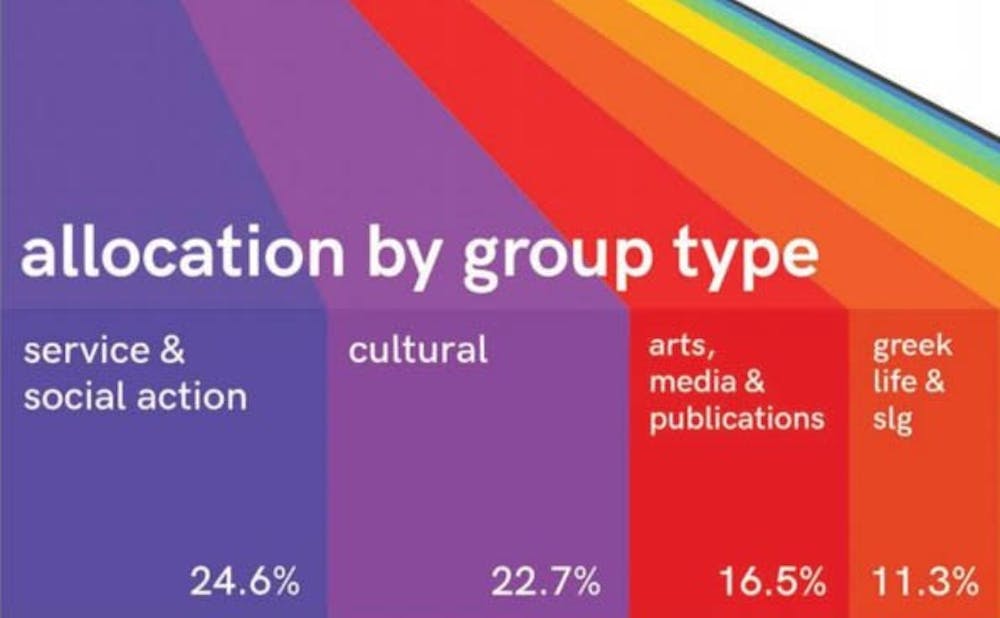All Duke undergraduates pay a student activities fee, but do you really know where your money goes?
Last year, each undergraduate paid $131.50 to fund student activities. Each year, the student activities fee is adjusted for inflation and distributed to Duke University Union, Duke Student Government and class councils.
Although the exact share that each of the three receives is uncertain, the majority goes to DUU and DSG, according to senior Luke Farrell, chair of student organization financing committee (SOFC). This article specifically investigates DSG’s use of student funds through SOFC.
DSG’s portion of the student activities fee is divvied up between its annual budget and programming events. At the start of each academic year, the annual budget is deducted from DSG’s portion, and the remainder is used for programming events.
Since the 2018-2019 annual budget is approximately $380,000, the programming fund for this upcoming academic year will be the remainder of DSG’s portion of the student activities fee.
The Chronicle was provided with a list of all programming funds from Aug. 17, 2017 to April 17, 2018.
The ins and outs of programming
Programming funds are for events hosted by student organizations that are open to and free for all undergraduates. Ranging from speaker fees to food orders, organizations can submit their receipts of the items and services already purchased to SOFC for reimbursement.
However, there are some exceptions to what SOFC will fund, including general body meetings, t-shirts, alcohol, decorations, group-only events and giveaways, according to the guidelines listed on SOFC's website.
In the past academic year, SOFC has approved and denied a wide variety of funding requests. The Asian Student Association received $100 for a fog machine for its Lunar New Year Show, but was denied $500 to pay for fortune cookies, red envelopes and stickers. In contrast, Business Oriented Women was provided $960 of of its $1,000 request to order Monuts delivery.
Farrell explained that SOFC does “a case-by-case evaluation” of programming events.
“If your organization has five people in it, I don’t think it makes your organization any less valuable than an organization that has 200 people in it,” he said.
No matter the size of the organization, Farrell said that all events can add "a lot of value to campus.”
During the 2017-2018 academic year, the student group that received the most programming funds was Blue Devils United, which was funded roughly $38,000. Trailing closely behind was the Duke Catholic Center, which received roughly $31,000. These two groups also requested the most SOFC programming funds compared to all other organizations.
The groups that receive more funds simply request them more frequently, Farrell noted.
“The problem with some organizations having disproportionate programming fees is not that they are asking too much, it’s that other groups are not asking enough," he said.
SOFC hosted six information sessions this year to teach organizations how to request programming funds. Their goal was to reach out to groups that do not often utilize the programming fund, Farrell explained.
However, funding for events does not just stop with SOFC.
“I think all groups have access to additional funding sources,” Farrell said. “Every group has a department they can ask, an additional fund they can ask. There are plenty of sources on campus.”
For example, service, social action and cultural groups have access to the Cultural Engagement Fund. Although these groups have access to other funding sources, service and social action groups receive the highest percentage of programming funds, and cultural groups the second highest.
“I think, compared to Greek life or [selective living groups], cultural groups are doing the most programming on campus. They have a ton of programming opportunities,” Farrell said. “And I think that is why they are represented there.”
He explained that differences between groups’ requested allocations and what they were actually funded may be attributed to not understanding SOFC guidelines.
“Where you see a very large disparity, it is because those groups did not realize what the rules were or were not made clear to them,” Farrell said.

The beast of the annual budget
It took over 29 hours to approve the $380,000 2018-2019 DSG annual budget. Senate must complete two readings of the budget prior to passage, so its April 4 and April 11 meetings cumulatively lasted for nine hours. SOFC also spent over 20 hours in annual budget hearings that spanned over three days–without breaking quorum—bring the total to 29 hours.
“That is really impressive. [SOFC] is very committed,” Farrell said. “We received a record low number of appeals both in programming and annual budget. That’s indicative of the fact that groups are happy because they understand what is happening.”
Farrell said he thinks positively of groups coming into Senate to present their appeals.
“Instead of us speculating of what a group wants or speculating what their needs are, it’s better to get it directly from that group,” Farrell said. “So, I think it is productive to have groups come in very often. Sometimes it is good to have a senator consult with those people, so they feel comfortable in this space because I know it can be an intimidating space.”
The items that SOFC funds for annual budgets compose quite an assorted bag. For example, organizations’ requests for T-shirts and stickers are not approved, but sticker makers are.
Farrell explained that T-shirts are not funded because they are “egregiously expensive” and funding them for one ground would translate into them being “universally requested” by all groups. SOFC also does not believe T-shirts to be “an effective way of spending student money,” he added.
“We fund 125 groups in the annual budget. If every single one of those groups got free T-shirts for every single one of their members, our annual budget would truly increase by $50,000," Farrell said.
There is a similar story for SOFC sticker funding. SOFC had over $10,000 of requests in stickers two years ago, but it did not fund them, Farrell said.
This year, however, DuARTS received funding for a sticker maker because it is a long-term investment, aligns with the organization’s mission and has a specific task to do creative and interesting things, according to Farrell.
“We are not going to fund a sticker maker for the next five years,” Farrell said. “[DuARTS] can keep that sticker maker and make any number of stickers they want for an extended period of time. So that was the kind of rationale for that very specific instance.”
Another piece to the annual budgeting puzzle includes student organizations in their first year. Their pieces do not seem to fit like the rest, as they are capped to $1,000 for their first year being chartered.
Comparing the annual budget to programming
Farrell believes programming funds are more efficient than annual budget allocations. As opposed to budget allocations being for conferences that organizations “might attend,” programming requests come before SOFC two weeks prior to their events with receipts for purchases that have already made.
He said he thinks programming events are important in particular because they are open to all students and have a “huge impact on campus culture.”
“It brings people outside of the group in and connects them with the kind of work that you are interested in doing, so actually programming is a really great thing,” Farrell said.
Even with the tradeoff that comes between programming and annual budget allocations, SOFC considers annual budgeting to be a “very separate” process from programming fund calculations.
Farrell said that although there are two distinct categories of groups—“programming groups” and “annual budget groups”—some groups fall in between.
He explained that SOFC does not want to create a “perverse incentive system” for “programming groups” to believe they will not have the same access to the annual budget as “annual budget groups,” and vice versa.
“It’s important for us to recognize that those are two separate needs and that we consider them separately,” Farrell said. “It’s not in our internal calculus to determine how much programming you do as we are calculating your annual budget allocation. You can be a great programming group and get hundreds of people and add a lot of value to campus. But, you could also have a large group that requires a lot of annual budgeting and that have a lot of internal leads.”
Get The Chronicle straight to your inbox
Signup for our weekly newsletter. Cancel at any time.

Stefanie Pousoulides is The Chronicle's Investigations Editor. A senior from Akron, Ohio, Stefanie is double majoring in political science and international comparative studies and serves as a Senior Editor of The Muse Magazine, Duke's feminist magazine. She is also a former co-Editor-in-Chief of The Muse Magazine and a former reporting intern at PolitiFact in Washington, D.C.

